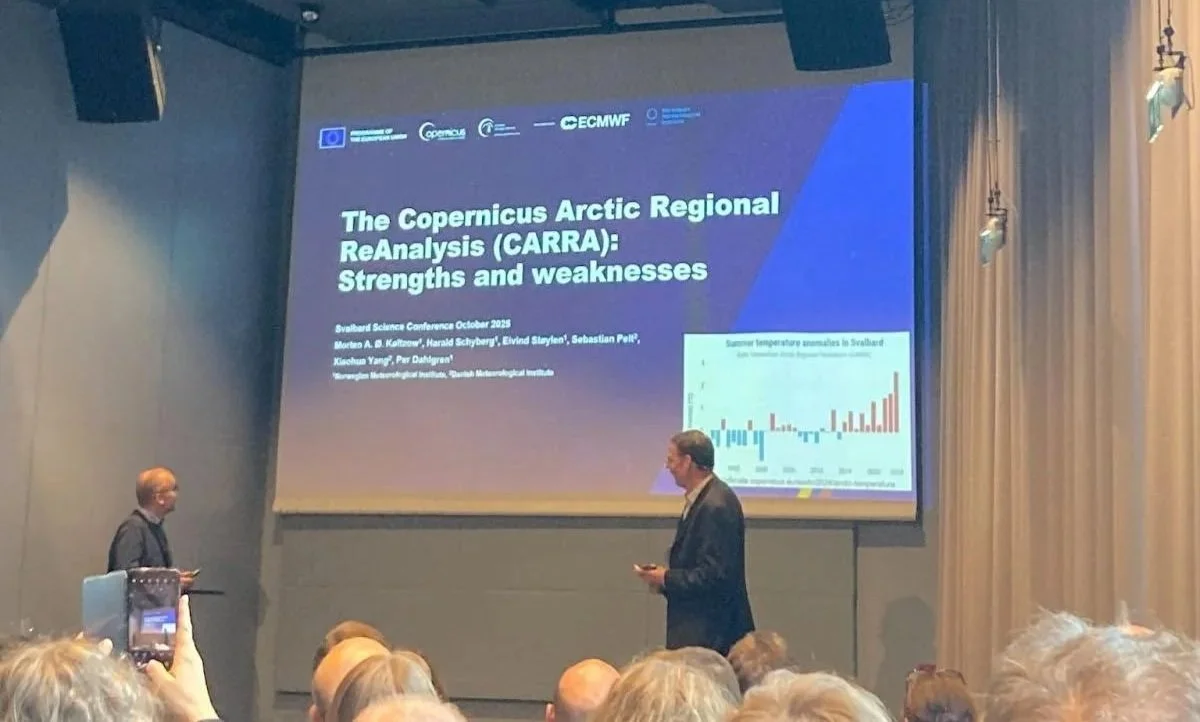PCAPS at the Svalbard Science Conference 2025
The 5th Svalbard Science Conference, held every 2 years, took place in Oslo, Norway, October 28 - 29, 2025. Scientists around the world gathered to discuss research in and about Svalbard. Among the speakers were PCAPS co-chair Jørn Kristiansen, DON4FS Task Team co-lead Malte Müller, and Verification Task Team members Cyril Palerme and Morten Køltzow.
Jørn presenting PCAPS at the first session of the Svalbard Science Conference 2025. Photo credit: Amanda Skogjordet
Jørn presented PCAPS in the first session of the conference, “Strategies for the next International Polar Year (IPY-5).” It was an interesting session and there was positive feedback about PCAPS. As the polar research community prepares for IPY-5, connecting science, services and society is even more important. Polar activities, ranging from research to tourism, are steadily increasing, and the need for accurate and reliable environmental forecasts is imperative for effective decision-making. Check out Jørn’s presentation here.
However, producing and using improved data is not a simple task. The Annual PCAPS Open Session held this year in Cambridge in April 2025 highlighted the bottlenecks that are currently present in the polar landscape, where issues with trust and reliability of polar forecasting data predominantly impacting their uptake. PCAPS advocates for enhanced environmental forecasting information in the polar regions that are not only more reliable, but also help to bridge the gap between research and operations, closing the loop between data production and data use. The biggest challenge we face therefore is working across disciplines and sectors to meet this goal.
Q&A with the first session of the Svalbard Science Conference 2025 presenters. From left: Henry Burgess (British Antarctic Survey/President of International Arctic Science), Per Erik Opseth (Norwegian Mapping Authority), Åshild Ønvik Pedersen (Norwegian Polar Institute), Jørn Kristiansen (Norwegian Meteorological Institute), and moderator Maria Philippa Rossi. Photo credit: Amanda Skogjordet
The Q&A after the first session was filled with important discussions. Notably, the need for interdisciplinarity was highlighted. In a natural science-dominated field like weather forecasting, there is much room for further and more robust social science research.
On Day 2 of the conference, Cyril Palerme from the PCAPS Verification Task Team presented in the; “New technologies and methods: how can they benefit polar science?” session. The presentation was about his sea-ice prediction system, MET-AICE.
Cyril presenting MET-AICE in the first session on Day 2 of the Svalbard Science Conference 2025. Photo credit: Amanda Skogjordet
Malte Müller from the DON4FS Task Team presented in the second part of the Technologies session, where he talked about the Svalbard Marginal Ice Zone campaign. He highlighted the importance for ground-based observations when there are uncertainties with using only satellite observations. Since 2021, there have been three campaigns (2021, 2024, 2025) on the sea ice north of Svalbard to put out buoys. There are now more than 60 buoys in total deployed. PCAPS was highlighted in his presentation as a forum for international collaboration.
Malte presenting about SvalMIZ at the Svalbard Science Conference 2025. Photo credit: Amanda Skogjordet
During the parallel session “Coast and fjords as systems in change,” Morten Køltzow - a member of the Verification Task Team - presented about the new CARRA-2 reanalysis, which will be released soon.
Morten (left) talking about the new CARRA-2 reanalysis at the Svalbard Science Conference 2025, with Gijs Breedveld (University Centre in Svalbard, right) introducing him. Photo credit: Jørn Kristiansen
The two days of the Svalbard Science Conference were filled with networking opportunities but importantly, critical discussions about the dire state of the Arctic. By meeting up in a common place and sharing research openly, talking about challenges and discussing experiences is not to be underestimated in supporting a better future for the Arctic.






